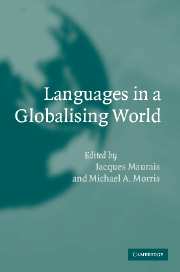Book contents
- Frontmatter
- Contents
- List of figures
- List of tables
- Notes on contributors
- Acknowledgements
- 1 Introduction
- Part I Global communication challenges
- Part II Major areas
- Part III Languages of wider communication
- 15 The international standing of the German language
- 16 Arabic and the new technologies
- 17 Russian in the modern world
- 18 Geolinguistics, geopolitics, geostrategy: The case of French
- 19 Towards a scientific geostrategy for English
- 20 On Brazilian Portuguese in Latin American integration
- Conclusion
- Index
20 - On Brazilian Portuguese in Latin American integration
Published online by Cambridge University Press: 18 November 2009
- Frontmatter
- Contents
- List of figures
- List of tables
- Notes on contributors
- Acknowledgements
- 1 Introduction
- Part I Global communication challenges
- Part II Major areas
- Part III Languages of wider communication
- 15 The international standing of the German language
- 16 Arabic and the new technologies
- 17 Russian in the modern world
- 18 Geolinguistics, geopolitics, geostrategy: The case of French
- 19 Towards a scientific geostrategy for English
- 20 On Brazilian Portuguese in Latin American integration
- Conclusion
- Index
Summary
It is estimated that the Portuguese language is spoken by about 200 million people. In quantitative terms, it ranks as the sixth most widely spoken language in the world, having spread from Portugal to various other countries. Such wide expansion and distribution originate in the Portuguese history of maritime explorations that led to the discovery of new lands and important commercial routes to the East. That is why today this language is present not only in various ex-Portuguese colonies but also in those regions where communication in Portuguese was common, as is the case of India and Southeast Asia.
Today, Portuguese is the national language of Brazil as well as the official tongue of Angola, Mozambique, Guinea-Bissau, Cape Verde, and São Tomé and Príncipe. Also, Macao in Asia keeps Portuguese as its official language, while near Australia the east part of Timor Island is trying to re-establish this language, forbidden during the occupation by Indonesia. As happens to every language spoken in different regions, Portuguese has a great number of variants. However, its linguistic unity is preserved due to the reiteration of the morphological and syntactic systems, in spite of the lexical diversity that affects its various linguistic strata in different territories.
The expansion of Portuguese as one of the most widely spoken languages of the world confirms that the history of languages – with respect to territorial reach and acceptability as a communication means – can be explained with reference to interests and needs related to economic, scientific and cultural exchanges.
- Type
- Chapter
- Information
- Languages in a Globalising World , pp. 313 - 316Publisher: Cambridge University PressPrint publication year: 2003



